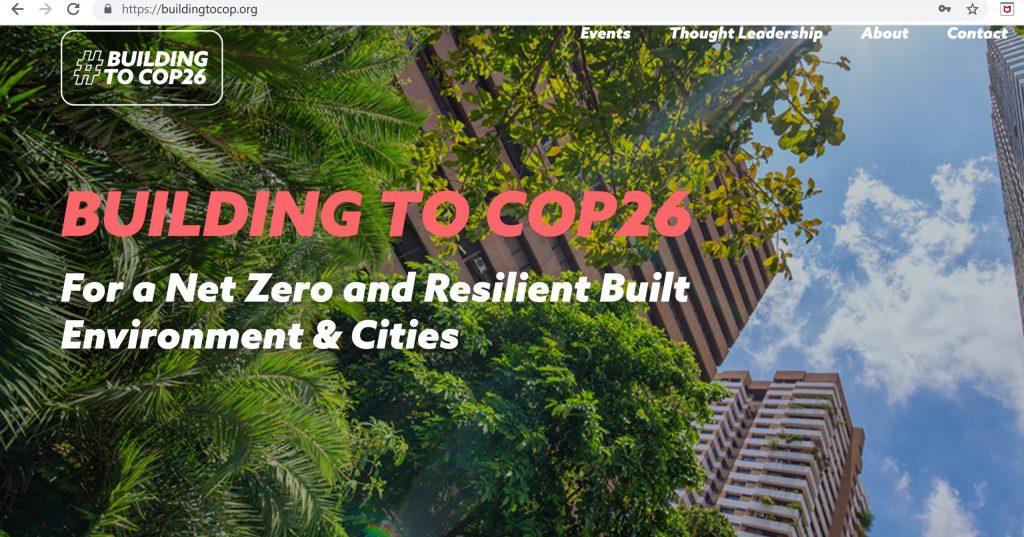The Building to COP26 Coalition has released its plans for #BuildingToCOP26 – ahead of Cities, Regions and Built Environment Day at COP26.
Following the sobering message from the IPCC Sixth Assessment Report, a coalition led by C40, the Global Alliance for Building and Construction (GlobalABC), The Resilience Shift, World Business Council for Sustainable Development (WBCSD) and World Green Building Council (WorldGBC) announce #BuildingToCOP26 — a partnership to promote radical collaboration for climate action ahead of the Cities, Regions and Built Environment Day at COP26.
The #BuildingToCOP26 Coalition — a group of business and government networks focused on sustainability in the built environment — are coming together for the first time to spotlight the built environment’s potential in accelerating climate action.
Working with the UN High Level Climate Champions, the COP26 Presidency and the UK’s Department for Business, Energy and Industrial Strategy (BEIS), the Coalition’s efforts will culminate on 11 November at the COP26 Cities, Regions and Built Environment Day, which will rally awareness, action and collaboration among all stakeholders in the built environment.
Why cities, regions and the built environment matter
Buildings are responsible for almost 40% of global energy-related carbon emissions and 50% of all extracted materials. By 2050, 1.6 billion urban dwellers will be regularly exposed to extremely high temperatures and over 800 million people living in more than 570 cities will be vulnerable to sea level rise and coastal flooding.
By 2050, the world’s building stock will double and almost 70% of the global population is projected to live in urban areas. By 2060, global material use is expected to more than double and a third of this rise is attributable to materials used in the building and construction system. The built environment’s demand on natural resources accelerates climate change, and inefficient, unhealthy buildings negatively impact human health and wellbeing. However, efficient buildings are one of the biggest investment opportunities worth an estimated $24.7 trillion by 2030.
Despite this, under $3 of every $100 spent on new construction goes to efficient buildings. Out of the 186 countries that have submitted Nationally Determined Contributions (NDCs) to the United Nations Framework Convention on Climate Change (UNFCCC), 136 countries mention buildings, 53 countries mention building energy efficiency, and 38 specifically call out building energy codes. Most countries do not include full building decarbonisation targets and certain areas such as building materials are under addressed.
To limit warming to no more than 1.5℃ as set out in the Paris Agreement, the Coalition calls for emissions from building projects globally to be halved by 2030, and to reach net zero life-cycle emissions for all buildings by no later than 2050.
In order to meet these decarbonisation targets and establish the built environment as a major solution provider to the climate crisis, the Coalition is promoting radical collaboration across the built environment system and spotlighting frontrunner action, solutions and policy pathways across business, cities and governments.
The Coalition aims to achieve three specific outcomes for COP26 and beyond:
- The system’s stakeholders unite behind a single voice and ambition towards shared goals:By 2030, the built environment should halve its emissions, whereby 100% of new buildings must be net zero carbon in operation, with widespread energy efficiency retrofit of existing assets well underway, and embodied carbon must be reduced by at least 40%, with leading projects achieving at least 50% reductions in embodied carbon.
By 2050, at the latest, all new and existing assets must be net zero across the whole life cycle, including operational and embodied emissions. (UNFCCC Human Settlements Pathway).
In parallel to decarbonisation targets, building resilience into the transformation of the built environment is critical to support urban populations and vulnerable communities in the face of future climate impacts. (UNFCCC Resilience Pathway).
- All countries are encouraged to include full building sector decarbonisation targets, concrete policies and measures, and related implementation mechanisms in their NDCs.GlobalABC is working with its country members and beyond on a country commitment ‘Buildings as Critical Climate Solution (BCCS)’ that will advance building sector measures at the national level, creating the appropriate enabling environment towards a zero-emission, efficient and resilient buildings and construction system.Learn more about how countries can incorporate buildings action into their NDCs and where the buildings and construction system is in supporting the ambitions of the Paris Agreement.
- 1,000 cities and at least 20% of the largest built environment businesses by revenue are committed to the UN’s Race to Zero.Businesses and sub-national governments are urged to join the Race to Zero and the Race to Resilience. The Race to Zero’s goal by COP26 is to have 20% of the built environment system by revenue to join the Race to Zero. This will create a ‘breakthrough point’ to help mainstream climate action in the system.
Cities are urged to join the Cities Race to Zero, as major policy enablers and owners of real estate who can go further, faster.
Nigel Topping, UN High Level Climate Champions for COP26, said:
“We can’t win the Race to Zero without winning the Race to Resilience as well. Climate breakdown and the pandemic multiply inequalities — social, environmental and economic gaps are widening across nations and across the Global North and South. By 2030, we must catalyse action by non-state actors that builds the resilience of four billion people from groups and communities who are vulnerable to climate risks.”
With focus and collaboration, the goal of halving the building sector’s emissions by 2030 is possible. The Coalition invites stakeholders across the built environment to join them to win the race to a zero emissions and resilient built environment, regions and cities.
Find out more at www.BuildingToCOP.org.

